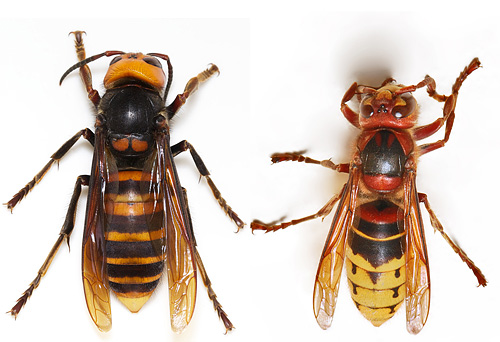
The Hornet genus is part of the Real wasp family. That is why outwardly all the hornets resemble the most common social wasps familiar to us, but at the same time they are much larger. Anyone who has ever met these insects in nature or just saw them side by side in one picture will be able to clearly tell where the hornet is and where, even if it is a large one, is a wasp.
With some other relatives of hornets, they are confused more often. For the most part, such mistakes are made, of course, by the townspeople, because they know hornets mainly only from pictures and therefore call any large insects that even remotely resembling them.
In total, there are 23 species of hornets in the world, very similar to each other in their lifestyle, but quite different in appearance. So, for example, the size of these insects varies from 2-2.5 cm in European hornets to 5 cm in giant Asian ones.
It is worth noting that representatives of both the smallest and largest species are found on the territory of Russia: the common (European) hornet on the one hand and the Vespa Mandarinia hornet (Asian giant) on the other.In general, the Asian hornet is common in the countries of Southeast Asia, but, nevertheless, its range reaches Primorye, where a meeting with this insect will not be a surprise for local residents.
Below in the photo is a giant Asian hornet, the largest and one of the most dangerous in the world:
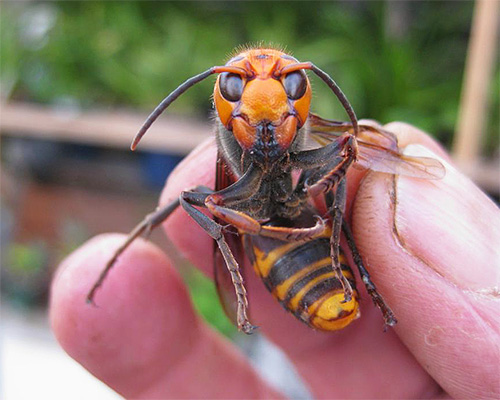
If we talk about the country as a whole, then most Russian gardeners and gardeners know better than others the common hornet - a large wasp up to 3.5 cm long. There are many myths and tales about this insect among the people.
Photo of a common hornet:
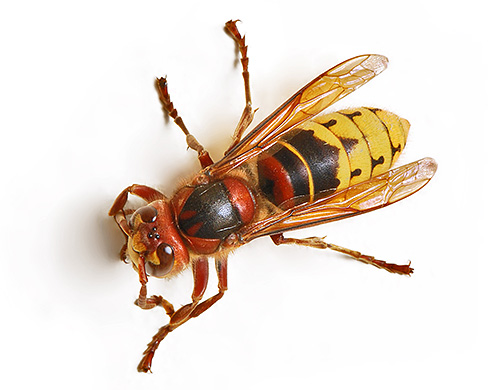
For example, it is generally accepted that a hornet sting is much more dangerous and more painful than a sting of an ordinary wasp, that three hornets together can kill a person, and seven - a horse ... It is also popularly said that nine bites inflicted at any time lead to the death of a person, or that, for example, one wasp has nine stingers. By the way, it is for this reason that the insect was popularly called the nine-hornet.
Needless to say, these are just idle fictions that have little in common with reality and have appeared as a result of insufficient awareness of ordinary people about the biology of these insects. But hornets, nevertheless, are still really dangerous for humans ...
Appearance and typical wasp features
Outwardly, the hornet looks quite impressive. The photo shows the characteristic features of the color of an ordinary European hornet:
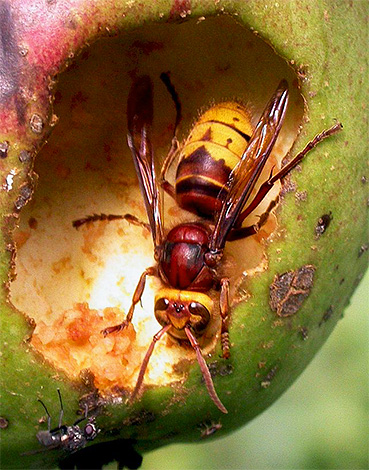
Some details of appearance distinguish these large insects well from ordinary wasps. So, hornets have a brown spot in the form of a noticeable arc on the upper side of the cephalothorax and the base of the abdomen and the back of the head of the same color. In turn, the common wasp does not have brown elements in color at all.
In the photo below - a hornet with a significant increase. All the characteristic details of his appearance are visible:
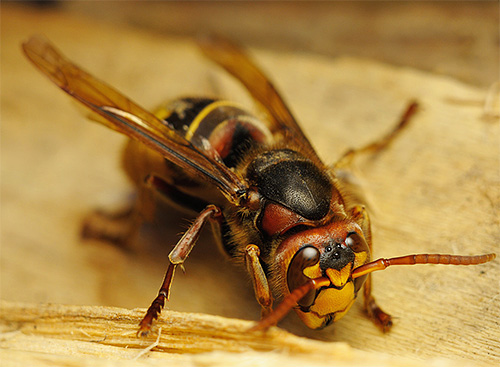
And here is a photo of an ordinary paper wasp:
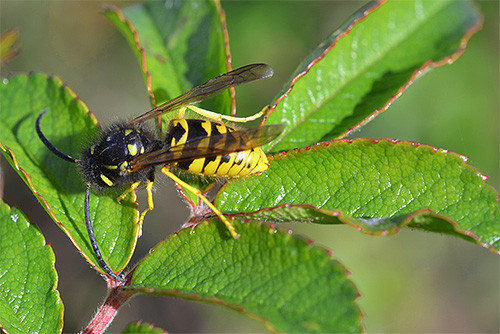
How else are wasps different from hornets? Of course, in size - usually a hornet is almost twice as large as its closest relatives. The next photo shows a hornet and a wasp nearby. The obvious difference in size immediately catches the eye:

The average size of a working individual of an ordinary hornet is 18-22 mm, the uterus is 28-30 mm. If we talk about wasps, their sizes fluctuate in the intervals of 12-14 mm and up to 18 mm, respectively.
It is interesting
Entomologists can distinguish hornets from just large wasps also by the shape of the head: the former have a very wide nape, while the latter, on the contrary, narrows when moving to the neck.
In general, the hornet has all the features that distinguish any hymenopteran insect. The hornet in the photo shows a very narrow, "wasp" waist, large eyes with a wide fit and powerful jaws, with which he gets food:

On a note
Very often in the southern regions of our country you can find an insect similar to a hornet in both general appearance and size, but differing in black color with two orange stripes on the abdomen. This is a scolia, also a large wasp, which, nevertheless, does not pose a danger to humans and, moreover, is very useful for agriculture (it destroys the larvae of large beetles). If the size of the hornet is approximately 25 mm, then the scoli can grow up to 45 mm. There is also a myth that a large blue hornet lives in our country. However, this is just a legend: in this case, a large carpenter bee, which really has a purple-blue body, is mistaken for a hornet.
In the video, the hornet guards the entrance to the hole where its nest is located:
Hornets near their nest
Hornet species: the most dangerous, largest and most aggressive
If we turn to schematic pictures and photos, it will become noticeable that all types of hornets are outwardly quite similar to each other, despite the significant difference in living conditions and sizes. In addition, the lifestyle, nutrition and reproduction of these insects are also generally similar. At the same time, all varieties of hornets have some separate, peculiar only to them, features of biology or anatomy.
Let's find out what hornets are, and dwell on the more "significant" of them.
The common (European) hornet is the most characteristic representative of the genus. It lives in Europe, in the European part of Russia, and not so long ago it was accidentally brought to the USA, where it multiplied and became a fairly common species.
Below are photographs of a hornet by which it will be possible to identify this insect if you accidentally meet it:
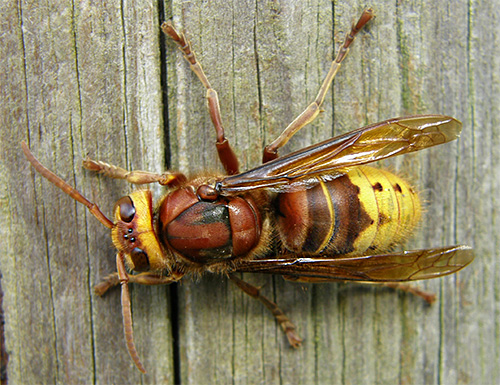
Review
“At our terminal, near the railway tracks, some huge wasps started up in the switchboard, because of which we could not open and service the entire cabinet. Somehow I picked up one such wasp under a box and looked at the pictures on the Internet. It turned out to be a hornet. I know that the hornet is a dangerous insect, but they didn’t bite anyone here, even though the compilers constantly walk nearby. We decided not to touch them with the whole workshop, and only in the event of some kind of accident, when in any case it will be necessary to climb to repair, poison them. There were no accidents, even the contractors were persuaded once for verification not to touch the cabinet.
Renat, Rostov-on-Don
The eastern hornet is one of the most beautiful among its brethren. It has an interesting red-brown body color with two broad yellow bands on the abdomen.
This species is known as the most drought-resistant, able to live and breed in dry steppes and deserts. The eastern hornet lives in Russia and throughout the Middle East. The photo shows a representative of this species of hornets:
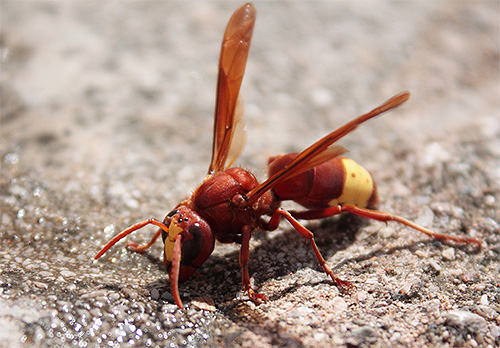
The giant Asian hornet is the largest species of the entire genus. This hornet looks like a fantastically enlarged European hornet, but without brown tones in color: its body length can reach up to 5 cm, and its wingspan can reach up to 6 cm! Such a hornet looks very intimidating and in its habitat is called the "bee sparrow".
Photo of a giant Asian hornet:

In addition, scientists divide this species into several subspecies, because. the largest hornet in the world has a number of varieties that differ in some features of biology. So, the most dangerous is the Japanese giant hornet - endemic to the Japanese islands, from the bites of which about 40 people die in this country every year.
No matter how far this giant may seem from us, it is not so difficult for Russians to meet him - they just need to go on vacation to India, Thailand or China. That is why, when planning to spend your vacation in these countries, refer at least to the pictures on the Internet depicting a huge hornet in order to be fully armed in case of emergency.
The black hornet is the only one of the whole genus that is a nest parasite of its fellows. His female does not raise her own family, but kills the queen in the nest of an ordinary or Japanese hornet and begins to manage a new home.This species is a typical example of the fact that hornets are of a completely different color than their vast majority.
The picture below shows black hornets:
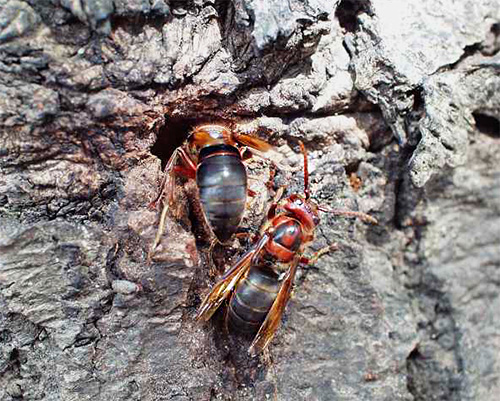
And then the photo shows two varieties of hornets - black and huge Asian.
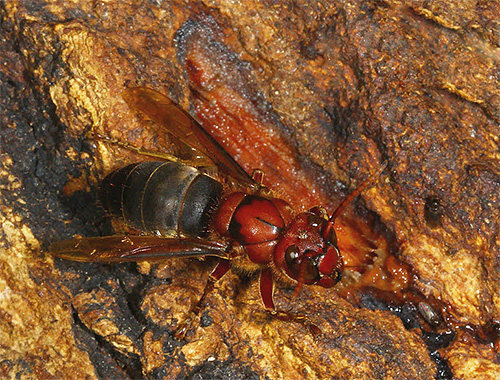
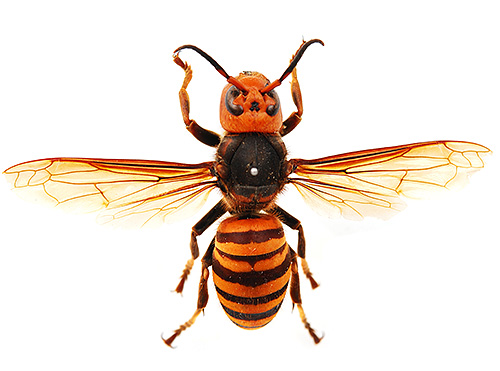
If we talk about interspecific interactions of different hornets in the same territory, then we can say with confidence that they are always hostile. Insects of equal size are competitors for food, larger species regard small ones as another prey, and the same black ones, in addition to everything else, also parasitize in the nests of their relatives.
Home for the hornet and the danger of their neighborhood with a person
All hornets are social insects. Their working individuals build nests from thin young tree bark, which they chew, mixing with saliva. The whole complex of honeycombs, consisting of a cardboard-like mass, is surrounded by outer walls and, when completed, becomes like a huge cocoon.

This design can simply hang on a branch or be attached to a building, or it can be located in a hollow tree or even in an animal's hole.
Often, hornets arrange their nests near garden plots and apiaries, where they feed on both harmful insects (beetles, bugs, caterpillars) and useful ones (for example, bees). It is not surprising that knowledgeable gardeners and gardeners respect these large wasps very much, but beekeepers do not like them very much.
When a hornet nest appears near the apiary, the owner of the honey farm tries to destroy it as soon as possible by any known means in order to avoid the extermination of the hives by these predators.
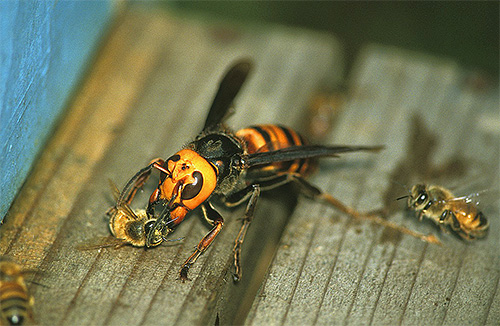
However, in relation to humans directly, hornets are non-aggressive insects.If they are not deliberately pursued and the nest is not threatened, they most likely will not sting anyone. Thus, hornet bites are usually either an unforeseen accident or purposeful protection by insects of their nest.
Review
“Once there was a case while fishing: we were driving a car, and a man was walking along the side of the road and staggering like a drunk. We stopped, we look, and his head is like a ball. He said that two hornets bit him on the head. Well, and a fuse, of course. We immediately put him in the car, a cold towel on his forehead, and the hospital is 42 km away. They didn’t take him, in short, he died in front of the village. The doctors said that the allergy was very strong.”
Semyon, Vilkovo
Reproduction of the largest wasps
Hornets breed in the same way as most of their relatives, their families almost never live more than one year.
In spring, the young female finds a suitable place for the nest (it should be secluded and protected from drafts), builds the initial combs and grows the first larvae in them. Immediately after breeding, the working hornets begin to care for the new brood and feed the queen, whose task is now reduced only to laying eggs.
Such well-coordinated work leads to the fact that the family begins to grow very quickly. The nest is completed just as quickly. If desired, it is easy to find numerous pictures on the Internet showing hornet dwellings at the initial and final stages of construction. Here is some of them:
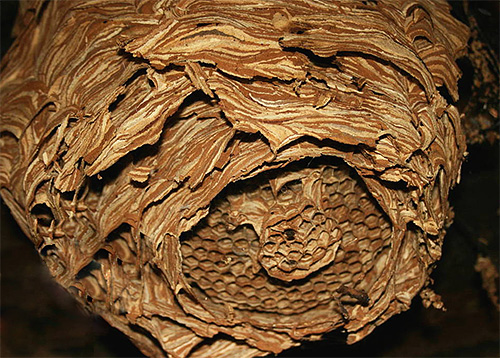

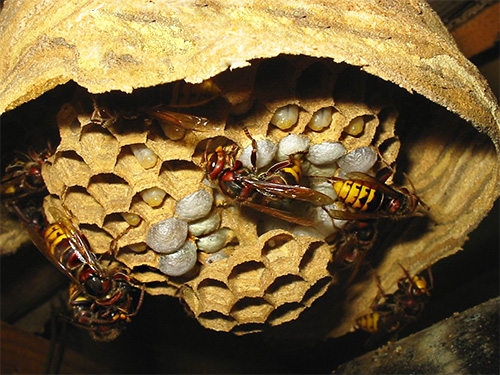
The larva of the hornet develops for about 4 weeks. Adult wasps feed it with caught insects, from which only the softest and fatty tissues are selected for the younger generation.
In the photo - hornet larvae in honeycombs:
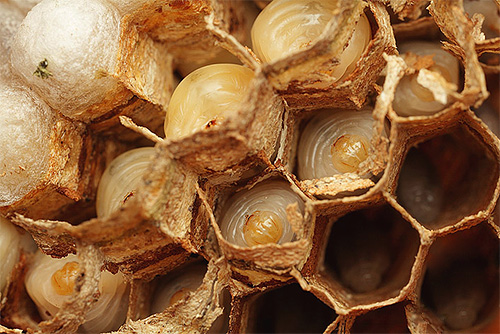
At the end of summer, instead of working hornets, females and males capable of breeding begin to hatch in the nest (all working individuals are barren females). The queen at this time can even be driven out of the nest or killed, because due to exhaustion she is no longer able to lay a sufficient number of eggs. Sexually mature hornets mate, after which the females scatter in search of shelters for wintering in order to establish their families with the onset of spring, and the males soon die.
A very interesting fact worth paying attention to is that for the female - the future founder of a new family - one mating at the end of the season is enough to lay eggs for the rest of her life.
One more interesting feature can be distinguished: in some tropical species of hornets, one of the young females is able to take the place of the mother and continue the development of the family.
How dangerous are hornets
Hornet venom is considered quite dangerous, but still not the strongest among the toxins of all insects in general. The main features of a hornet bite are an allergic reaction that manifests itself in a person after a sting, and a large amount of poison introduced into the body. It is serious doses of poison that cause such serious consequences, even though its toxicity is generally lower than, for example, the toxicity of bee venom.
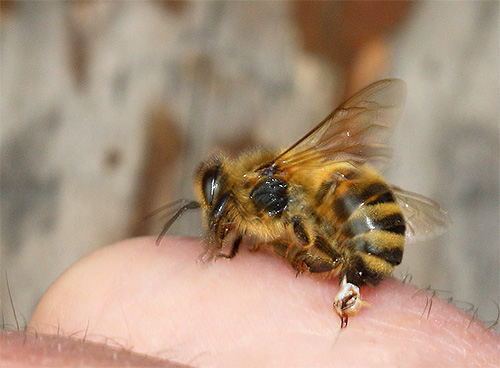
If a stung person is not hypersensitive to insect poisons, then a hornet bite will only cause pain, swelling and inflammation, which will disappear within a few days.
Another thing is when a person’s immunity cannot cope with the toxin that has entered the body.In this case, hornet venom causes a severe allergic reaction, manifested by dizziness, increased heart rate, fever, Quincke's edema, pain and even anaphylactic shock.
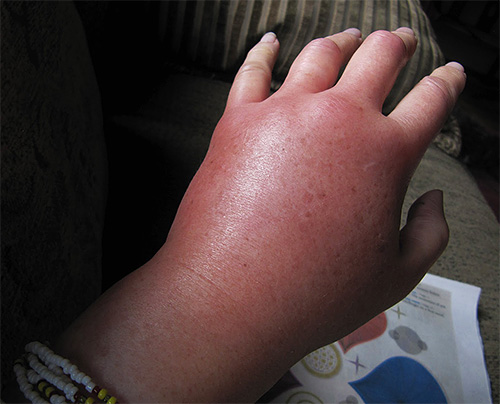
It should be noted that from bite to bite, the body's sensitivity to poison really increases, and therefore, if it is still available, the 9 bites rule mentioned above may well work.
Review
“I have some kind of instinctive fear of hornets after a hornet bit my lip as a child. I was so blown away that both eyes were swollen and my mouth did not open at all. Barely breathed. They took me to the doctor, gave me injections, and that’s why everything went without consequences.”
Yana, Nizhny Novgorod
How to deal with hornets
The fight against hornets is justified only if they threaten the apiary or settle in the center of a residential area, where they interfere with work. If the hornets place their nest where no one disturbs it, then they will not interfere with the owners of the site, and on the contrary, they will actively help, destroying many pests in the garden or in the garden.
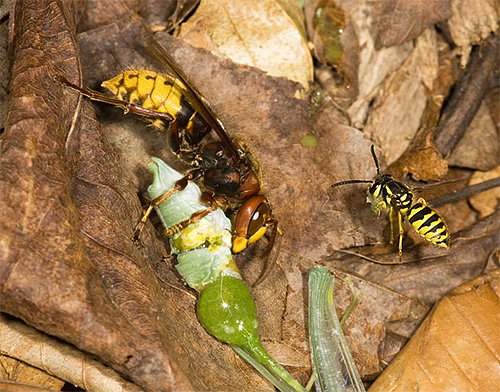
In the event that peaceful coexistence is still impossible, hornets are fought with several methods:
- hang traps with baits, into which insects fall as if in a trap;
- directly destroy the nest itself - for example, burn it;
- they treat the hornets' dwelling with strong insecticides, which leads to the death of the whole family.
For humans, the first method is the safest, but, however, it does not guarantee the complete extermination of insects, i.e. is just a way to deal with them. Completely destroying the nest or poisoning its inhabitants means getting rid of them for sure.But do not forget that the corresponding extermination work must be carried out, observing very strict safety regulations.
In general, it should be remembered that due to active, sometimes simply thoughtless extermination, the number of hornets in many regions of our country is drastically decreasing. To date, even the common hornet is listed in some regional Red Books, therefore, if it is possible to get along with these insects, it is better not to touch them, save their lives. And they, in turn, will do everything possible to destroy as many pests as possible in your garden.
An interesting video about the danger of neighborhood with a nest of hornets
Giant Asian hornet vs scorpion - who wins?



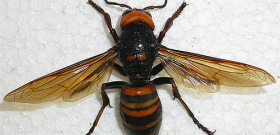
I liked the article very much, I did not expect that the hornet turned out to be so big.
Very good article, thanks.
The hornets have made a nest in our attic. We don't touch them and they don't touch us. We are waiting for autumn, because. we read that in the autumn they will die themselves. Only one is annoying. When the larvae hatch, their shell begins to rot. The smell of rotten cabbage. Very unpleasant.
A few years ago, in the forest in the garden, I saw a very large hornet. Sorry, but it was more than 10 cm. Our house is sheathed with narrow boards 10 cm wide, and so, the hornet sat across this board and was longer than the width of the board. At first, my relatives laughed at me, they said that fear has big eyes, although I did not determine the size of the insect by eye, but in comparison with the width of the board. And after some time, they said on TV that huge hornets appeared in some areas, more than 10 cm. When it took off, it looked like a heavy loaded plane and flew very low above the ground.